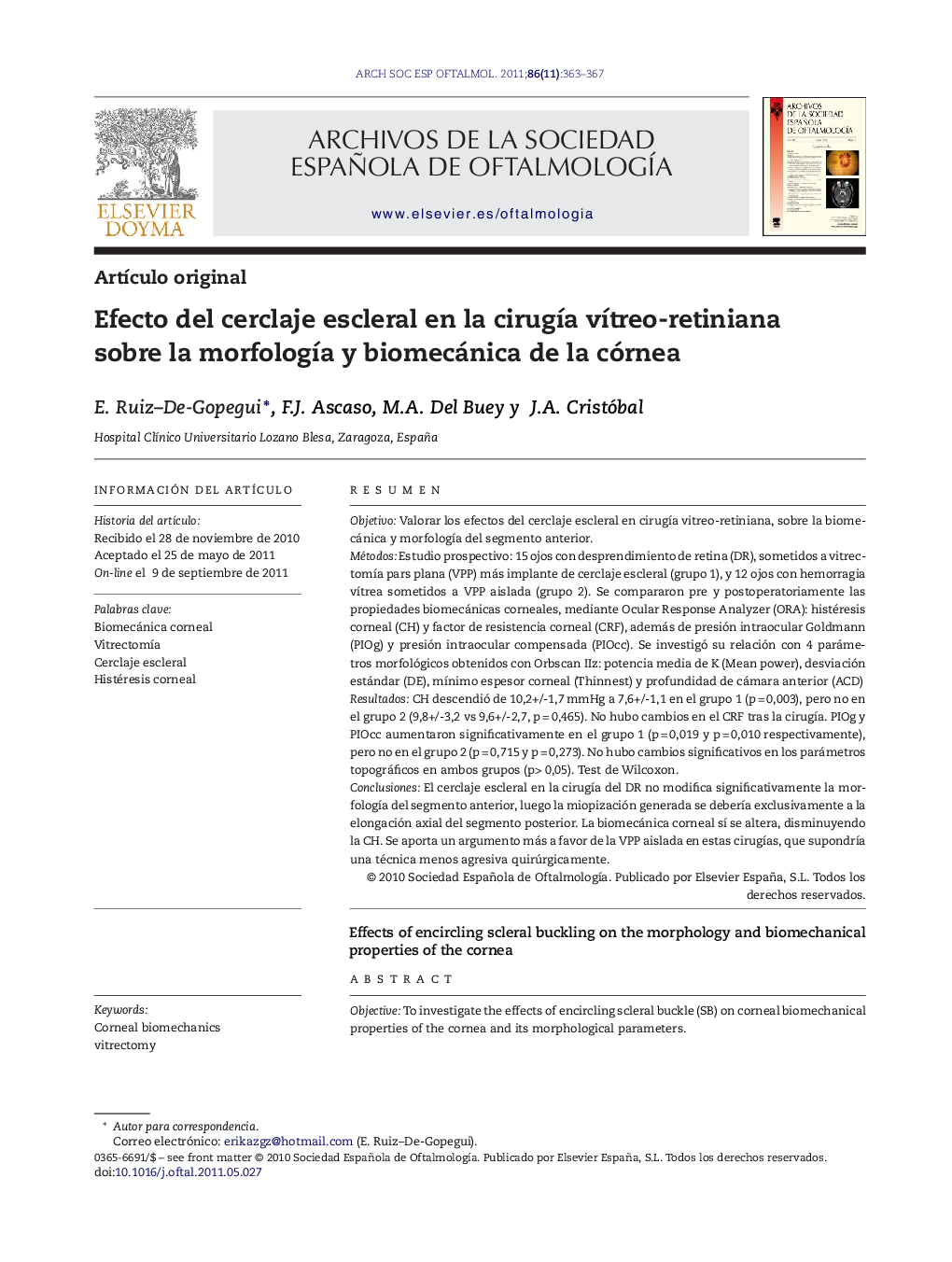| Article ID | Journal | Published Year | Pages | File Type |
|---|---|---|---|---|
| 4007688 | Archivos de la Sociedad Española de Oftalmología | 2011 | 5 Pages |
ResumenObjetivoValorar los efectos del cerclaje escleral en cirugía vitreo-retiniana, sobre la biomecánica y morfología del segmento anterior.MétodosEstudio prospectivo: 15 ojos con desprendimiento de retina (DR), sometidos a vitrectomía pars plana (VPP) más implante de cerclaje escleral (grupo 1), y 12 ojos con hemorragia vítrea sometidos a VPP aislada (grupo 2). Se compararon pre y postoperatoriamente las propiedades biomecánicas corneales, mediante Ocular Response Analyzer (ORA): histéresis corneal (CH) y factor de resistencia corneal (CRF), además de presión intraocular Goldmann (PIOg) y presión intraocular compensada (PIOcc). Se investigó su relación con 4 parámetros morfológicos obtenidos con Orbscan IIz: potencia media de K (Mean power), desviación estándar (DE), mínimo espesor corneal (Thinnest) y profundidad de cámara anterior (ACD)ResultadosCH descendió de 10,2+/-1,7 mmHg a 7,6+/-1,1 en el grupo 1 (p = 0,003), pero no en el grupo 2 (9,8+/-3,2 vs 9,6+/-2,7, p = 0,465). No hubo cambios en el CRF tras la cirugía. PIOg y PIOcc aumentaron significativamente en el grupo 1 (p = 0,019 y p = 0,010 respectivamente), pero no en el grupo 2 (p = 0,715 y p = 0,273). No hubo cambios significativos en los parámetros topográficos en ambos grupos (p> 0,05). Test de Wilcoxon.ConclusionesEl cerclaje escleral en la cirugía del DR no modifica significativamente la morfología del segmento anterior, luego la miopización generada se debería exclusivamente a la elongación axial del segmento posterior. La biomecánica corneal sí se altera, disminuyendo la CH. Se aporta un argumento más a favor de la VPP aislada en estas cirugías, que supondría una técnica menos agresiva quirúrgicamente.
ObjectiveTo investigate the effects of encircling scleral buckle (SB) on corneal biomechanical properties of the cornea and its morphological parameters.MethodsWe prospectively examined twelve eyes diagnosed with vitreous haemorrhage undergoing pars plana vitrectomy (PPV), and fifteen eyes undergoing combined PPV and scleral buckle (PPV/SB) for repair of rhegmatogenous retinal detachment (RRD). Corneal biomechanical properties, including corneal hysteresis (CH) and corneal resistance factor (CRF), were measured with an Ocular Response Analyser (ORA) before and 1-month postoperatively. The ORA also determined the values of intraocular pressure (IOPg) and corneal compensated IOP (IOPcc). Finally, four morphological parameters of the cornea were measured with the Orbscan II topographer (Orbtek, Inc.): mean corneal power, thinnest corneal point (μm), and anterior chamber depth (ACD).ResultsCH decreased significantly from 10.2+/-1.7 mmHg to 7.6+/-1.1 mmHg after PPV/SB (p = 0.003), but not after PPV alone (9.8+/-3.2 mmHg vs 11.6+/-2.7 mmHg, P = .465). CRF did not change significantly after surgery in both groups. IOPg and IOPcc increased significantly in the PPV/SB group (P = .019 and P = .010, respectively) but not in PPV group (P = .715 and P = .273, respectively). Unlike the PPV group, values were significantly higher than IOPg values before (P = .001) and after surgery (P = .003) in the PPV/SB group IOPcc. Neither the PPV/SB group nor the PPV group showed any significant changes in the corneal morphological parameters after surgery (P > .05).ConclusionsSB surgery leads to a change in the corneal biomechanical properties without altering corneal morphological parameters. It may cause an underestimation error in IOP measurement. PPV may be a less invasive surgical approach for the repair of noncomplex RRD than PPV/SB.
